Office Room Interior Design: Creating Inspiring Workspaces
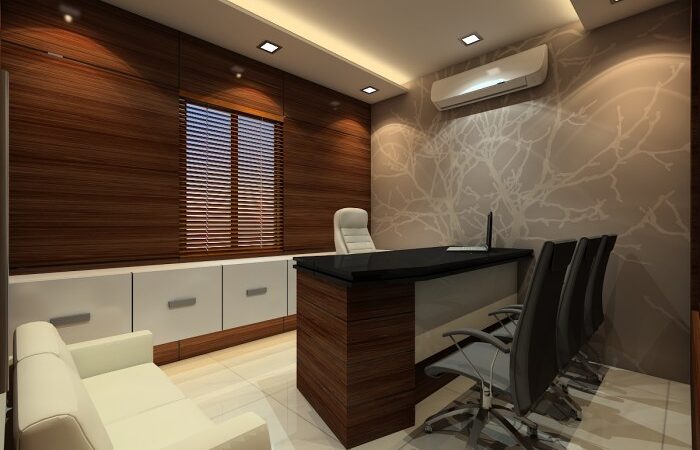
Office room interior design is more than just aesthetics; it’s about crafting an environment that fosters productivity, creativity, and well-being. From choosing the right color palette to incorporating ergonomic furniture and sustainable materials, every design decision plays a crucial role in shaping the overall atmosphere and functionality of the workspace.
This comprehensive guide explores the key elements of office room interior design, providing insights into layout, functionality, color schemes, ergonomics, technology integration, and sustainable practices. We’ll delve into the importance of creating a cohesive and inspiring environment that reflects the brand identity and fosters a positive work culture.
Understanding the Office Space
The design of an office space plays a crucial role in fostering productivity, collaboration, and employee well-being. To effectively design an office, a thorough understanding of the space’s purpose, target audience, and desired atmosphere is essential.
Purpose of the Office Space
The purpose of the office space determines the layout, functionality, and overall design aesthetic. For example, a creative agency might prioritize open floor plans and collaborative workspaces, while a law firm might favor private offices and conference rooms for client meetings.
Layout and Functionality
The layout of an office space significantly influences its functionality and overall efficiency. A well-designed layout optimizes workflow, enhances collaboration, and creates a comfortable and productive environment. This section delves into the principles of designing a layout that maximizes space and flow, identifies key work areas, and discusses the use of furniture and storage solutions.
Space Maximization and Flow, Office room interior design
Optimizing space utilization is crucial for creating an efficient and functional office environment. A well-planned layout ensures that every square foot is used effectively, minimizing wasted space and maximizing productivity. The following points highlight key strategies for maximizing space and flow:
- Open Plan Layout: This layout eliminates walls and partitions, creating a more open and collaborative environment. It is particularly suitable for smaller offices or teams that require frequent interaction. Open-plan layouts can enhance communication and teamwork, fostering a sense of community.However, they may also present challenges in terms of noise control and privacy.
- Modular Furniture: Utilizing modular furniture allows for flexible configurations that can be adapted to changing needs. Modular desks, workstations, and storage units can be rearranged easily, enabling efficient use of space and accommodating team growth or changes in workflow. This flexibility also provides the ability to create dedicated areas for specific tasks or team projects.
- Strategic Furniture Placement: The placement of furniture significantly influences the flow of movement within the office. Placing desks and workstations in a way that facilitates easy access and minimizes bottlenecks is crucial. Strategic placement can also create distinct zones for different activities, such as collaboration areas, quiet workspaces, and meeting rooms.
- Vertical Space Optimization: Utilizing vertical space is a key aspect of maximizing space. This can be achieved through the use of tall bookshelves, wall-mounted storage units, and overhead cabinets. By maximizing vertical space, floor area becomes more available for workstations and other essential elements.
Key Work Areas and Functions
Identifying and defining key work areas is essential for creating a functional and efficient office layout. Each area should be designed to support specific tasks and workflows. The following points highlight common work areas and their functions:
- Individual Workstations: These are the primary workspaces for individual employees. They should provide sufficient desk space, storage, and ergonomic seating to support focused work. Individual workstations should be designed to minimize distractions and promote concentration.
- Collaboration Areas: These areas are designed for team meetings, brainstorming sessions, and collaborative projects. They typically include comfortable seating, whiteboards, and tables for shared work. Collaboration areas should be located in a central location, accessible to all team members.
- Meeting Rooms: Meeting rooms are dedicated spaces for formal meetings, presentations, and client interactions. They should be equipped with comfortable seating, a large screen or projector, and a whiteboard or flip chart. The size and configuration of meeting rooms should be determined by the typical size of meetings and the needs of the organization.
- Breakout Areas: Breakout areas are informal spaces for relaxation, socializing, and informal meetings. They can include comfortable seating, coffee machines, and a small kitchenette. Breakout areas provide a space for employees to unwind and recharge, promoting a positive and supportive work environment.
Furniture and Storage Solutions
The selection of furniture and storage solutions is crucial for creating a functional and aesthetically pleasing office space. Furniture should be comfortable, durable, and designed to support the specific needs of the workplace. Storage solutions should be organized, accessible, and visually appealing.
The following points guide selecting furniture and storage solutions:
- Ergonomic Seating: Ergonomic chairs are essential for supporting good posture and reducing discomfort during long work hours. They should provide adjustable height, lumbar support, and armrests. Choosing ergonomic chairs can contribute to employee well-being and productivity.
- Adjustable Desks: Adjustable desks allow employees to customize their workspaces to their height and posture preferences. This can improve comfort, reduce strain on the back and neck, and promote a healthy work environment.
- Storage Solutions: Efficient storage solutions are essential for maintaining an organized and clutter-free office space. Storage options should be chosen based on the specific needs of the organization, such as filing cabinets, shelves, drawers, and wall-mounted storage units.
Color Palette and Materials
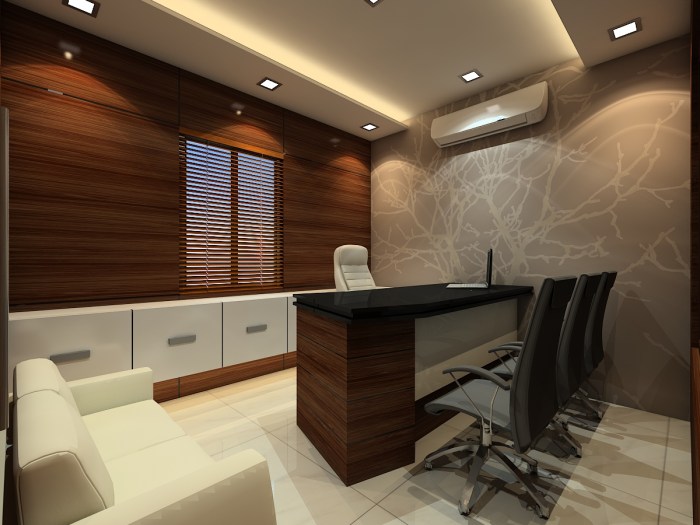
The color palette and materials chosen for an office space significantly impact the overall atmosphere and functionality. They can create a sense of professionalism, inspire creativity, or promote relaxation. Carefully selecting colors and materials that align with the company’s brand and desired ambiance is crucial.
Color Palette
The color palette should reflect the company’s brand identity and the desired atmosphere for the office. Consider the following factors when selecting a color palette:
- Brand Colors: If the company has established brand colors, these should be incorporated into the office design. This creates a consistent brand experience across all touchpoints.
- Desired Atmosphere: The desired atmosphere will influence the choice of colors. For example, a calming and relaxing atmosphere might use soft blues and greens, while a stimulating and energetic atmosphere might use bright yellows and oranges.
- Psychology of Color: Different colors have different psychological effects. For example, blue is often associated with trust and calmness, while red is associated with energy and excitement. Understanding the psychology of color can help you choose colors that will evoke the desired emotions in the office space.
- Lighting: The color palette should be considered for the natural and artificial lighting in the office. Darker colors can absorb light, making the space feel smaller and darker, while lighter colors can reflect light, making the space feel larger and brighter.
Materials
The materials used for furniture, walls, and flooring play a significant role in the overall look and feel of the office. Consider the following factors when selecting materials:
- Durability: Office furniture and materials should be durable and able to withstand wear and tear. Consider the traffic patterns and the level of use the space will receive.
- Comfort: Comfortable furniture and materials are essential for employee productivity and well-being. Choose materials that are soft, supportive, and aesthetically pleasing.
- Sustainability: Consider using sustainable materials whenever possible. This can include recycled materials, renewable resources, and materials with low environmental impact.
- Aesthetics: The materials should complement the color palette and overall design aesthetic of the office. They should also be appropriate for the company’s brand and the desired atmosphere.
Natural and Artificial Lighting
Natural light is essential for a healthy and productive work environment. It can improve mood, reduce stress, and enhance creativity. However, artificial lighting is also necessary for providing adequate illumination in the office.
- Maximizing Natural Light: Design the office space to maximize natural light. This might involve using large windows, skylights, or lightwells. Avoid placing furniture in front of windows that block natural light.
- Artificial Lighting: Use a combination of ambient, task, and accent lighting to create a well-lit and functional workspace. Ambient lighting provides general illumination, task lighting provides focused light for specific tasks, and accent lighting highlights features or objects in the space.
- Lighting Control: Implement lighting control systems that allow employees to adjust the lighting levels to suit their individual needs and preferences. This can include dimming switches, motion sensors, and daylight sensors.
Ergonomics and Comfort
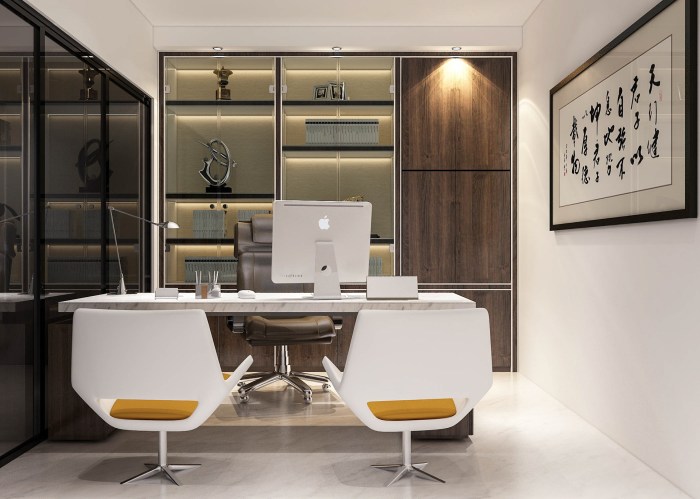
Creating a comfortable and ergonomic office environment is essential for enhancing employee productivity, reducing the risk of injuries, and fostering a positive work culture. Ergonomics focuses on designing workspaces that minimize strain and promote well-being.
Ergonomic Furniture and Workspaces
Ergonomic furniture and workspaces play a crucial role in supporting a healthy posture and reducing the risk of musculoskeletal disorders.
- Adjustable Chairs: Chairs with adjustable height, lumbar support, and armrests allow users to find a comfortable and supportive position. They promote proper posture and reduce pressure on the spine, neck, and shoulders.
- Standing Desks: Standing desks encourage movement and can help alleviate the negative effects of prolonged sitting. They can be adjusted to different heights, allowing employees to switch between sitting and standing positions throughout the day.
- Ergonomic Keyboard and Mouse: These devices are designed to reduce strain on the wrists and hands. They often feature a split or curved design that promotes a more natural hand position.
- Monitor Placement: Placing monitors at eye level and a comfortable distance from the user can help prevent neck strain and eye fatigue.
Sound-absorbing materials and Acoustic Treatments
Excessive noise can be distracting and stressful, impacting concentration and productivity. Sound-absorbing materials and acoustic treatments are essential for creating a quiet and focused work environment.
- Acoustic Panels: These panels are often made of materials like foam, fabric, or wood and are designed to absorb sound waves, reducing echoes and reverberation.
- Carpet: Carpet can help to absorb sound and reduce noise levels, particularly in open-plan offices.
- Plants: Plants can act as natural sound absorbers, contributing to a more peaceful and serene atmosphere.
Features Promoting Comfort and Well-Being
Creating a comfortable and welcoming office environment is essential for employee well-being and productivity.
- Natural Light: Maximizing natural light in the workspace can improve mood, reduce eye strain, and enhance overall well-being.
- Temperature Control: A comfortable temperature is essential for productivity and comfort. Consider using thermostats and ventilation systems to maintain a pleasant indoor climate.
- Breakout Areas: Providing designated areas for breaks and informal meetings can encourage relaxation and collaboration. These areas can be furnished with comfortable seating, tables, and perhaps even a coffee bar.
Technology and Connectivity: Office Room Interior Design
In today’s modern workplace, technology plays a crucial role in enhancing productivity and communication. A well-designed office space must seamlessly integrate technology to support the needs of its occupants. This section explores the importance of technology integration and connectivity in office design.
Wiring, Cabling, and Power Outlets
A robust infrastructure for wiring, cabling, and power outlets is essential for a technologically advanced office. This infrastructure must be carefully planned and executed to ensure reliable connectivity and power supply for all devices.
- Data Cabling: High-speed internet connectivity is critical for seamless communication, collaboration, and access to online resources. Cat 6 or Cat 6a cabling is commonly used for reliable data transmission, supporting high-bandwidth applications.
- Power Outlets: Adequate power outlets are necessary for all electronic devices, including computers, printers, and other peripherals.Power outlets should be strategically placed for ease of access and to minimize clutter.
- Wireless Connectivity: Wi-Fi is becoming increasingly essential for mobile work and collaboration. A strong Wi-Fi network with multiple access points ensures reliable connectivity throughout the office space.
Ensuring Reliable Connectivity
Reliable connectivity is crucial for productivity and seamless workflow. Here are key strategies to ensure reliable connectivity:
- Redundancy: Implementing redundant systems, such as backup internet connections and power generators, minimizes downtime in case of network or power outages.
- Network Monitoring: Monitoring network performance allows for proactive identification and resolution of potential connectivity issues.
- Professional Installation: Professional installation of wiring, cabling, and power outlets ensures proper installation and minimizes future issues.
Decorative Elements
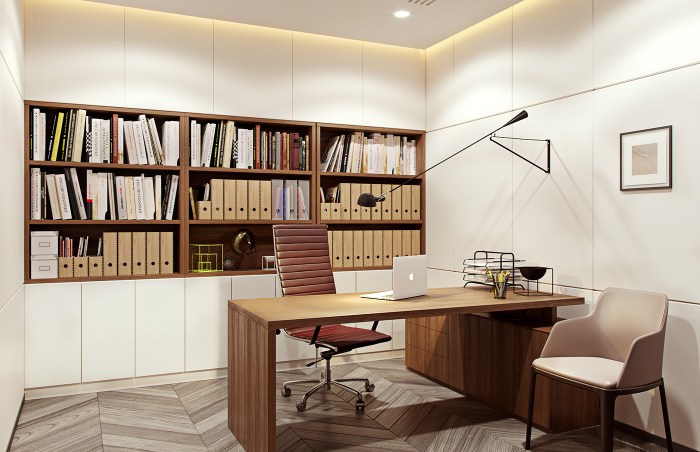
Decorative elements play a crucial role in enhancing the aesthetic appeal of an office space, creating a welcoming and inspiring environment for employees. By strategically incorporating artwork, plants, and other decorative items, you can infuse personality and character into the workspace, fostering a sense of creativity and well-being.
Artwork
Artwork can transform a bland office into a vibrant and engaging space. It can be used to create a focal point, add color, and reflect the company’s culture and values. Consider incorporating:
- Abstract paintings: These can add a touch of sophistication and intrigue to the space, sparking conversations and stimulating creativity.
- Photography: Black and white or color photographs can evoke different moods and emotions, adding depth and visual interest to the office.
- Sculptures: These can be a statement piece, adding a touch of artistry and personality to the space. They can also be used to break up the monotony of straight lines and add a sense of movement.
When selecting artwork, ensure it complements the overall design theme and color palette of the office.
Plants
Plants bring a touch of nature indoors, creating a more calming and refreshing atmosphere. They can also help improve air quality and boost employee productivity. Consider incorporating:
- Low-maintenance plants: These are ideal for busy offices as they require minimal care. Examples include snake plants, ZZ plants, and peace lilies.
- Air-purifying plants: These can help improve air quality, reducing headaches and fatigue. Examples include spider plants, English ivy, and aloe vera.
- Flowering plants: These can add a splash of color and brighten up the office. Examples include orchids, African violets, and geraniums.
Ensure plants are strategically placed to receive adequate sunlight and are watered regularly.
Other Decorative Items
Other decorative items can be used to add personality and warmth to the office space. Consider incorporating:
- Rugs: Rugs can add warmth, texture, and color to the floor, defining different areas within the office and creating a sense of comfort.
- Throws and pillows: These can add a touch of softness and comfort to seating areas, making them more inviting.
- Lighting: Strategic lighting can create a welcoming and inspiring atmosphere. Consider using a combination of natural and artificial light, with task lighting for work areas and ambient lighting for social spaces.
Sustainability and Green Design
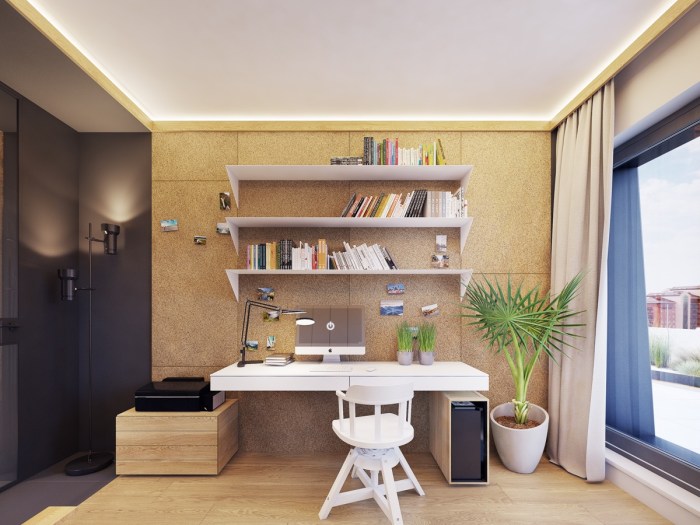
In today’s world, sustainability is a crucial aspect of every design decision. Applying green design principles to your office space not only benefits the environment but also creates a healthier and more productive workspace for your employees. This section will explore the ways to incorporate sustainability into your office design.
Sustainable Materials and Practices
Sustainable materials and practices are essential for creating an environmentally responsible office. These materials have a lower environmental impact throughout their lifecycle, from sourcing and manufacturing to disposal.
- Choosing sustainable materials: Opt for materials like bamboo, recycled plastic, and reclaimed wood. These materials are renewable, durable, and reduce the need for virgin resources.
- Using eco-friendly finishes: Consider using low-VOC paints and finishes that emit fewer harmful chemicals into the air. This helps improve indoor air quality and creates a healthier environment for your employees.
- Implementing green cleaning practices: Use eco-friendly cleaning products and encourage employees to practice sustainable habits like recycling and reducing waste.
Energy-Efficient Lighting and Appliances
Energy-efficient lighting and appliances significantly reduce energy consumption, lowering your office’s carbon footprint and utility bills.
- LED Lighting: LED lights are highly energy-efficient, lasting longer than traditional incandescent bulbs and consuming significantly less energy.
- Motion Sensor Lighting: Motion sensors automatically turn lights on when someone enters a room and off when the room is empty, saving energy by preventing lights from being left on unnecessarily.
- Energy-Efficient Appliances: Select appliances like refrigerators, printers, and computers with Energy Star ratings, indicating they meet specific energy efficiency standards.
Recycled and Renewable Materials
Using recycled and renewable materials minimizes the need for virgin resources and reduces waste.
- Recycled Content: Look for furniture, flooring, and other materials made from recycled content. This reduces the demand for new materials and helps conserve natural resources.
- Renewable Materials: Bamboo, cork, and reclaimed wood are examples of renewable materials that can be used in office design. These materials are sustainable and often have unique aesthetic qualities.
Inspirational Office Design Examples
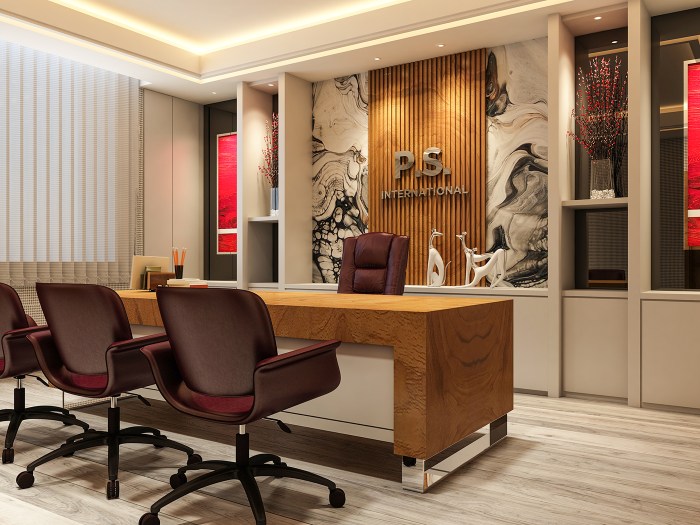
Office design is constantly evolving, driven by changing work styles, technological advancements, and a growing emphasis on employee well-being. Innovative office designs are not just about aesthetics but also about fostering collaboration, creativity, and productivity. This section will explore several inspiring examples of office design concepts that showcase these trends.
Examples of Innovative Office Design Concepts
These examples demonstrate how innovative office design can create dynamic and inspiring work environments. Each example incorporates unique features and design elements that cater to specific needs and foster a positive work culture.
| Image Description | Key Features | Design Style | Inspiration |
|---|---|---|---|
| A modern office space with a large, open layout. The space is filled with natural light, featuring a mix of collaborative work areas, individual workstations, and informal meeting spaces. The walls are adorned with vibrant artwork and plants, creating a lively and stimulating atmosphere. | Open floor plan, natural light, collaborative work areas, individual workstations, informal meeting spaces, vibrant artwork, and plants. | Modern, open-plan, biophilic design. | The design aims to create a flexible and inspiring workspace that promotes collaboration and well-being. |
| A tech-focused office space with a sleek and minimalist design. The office features high-tech amenities such as smart lighting, interactive displays, and ergonomic furniture. The color palette is dominated by neutral tones with pops of bright color, creating a modern and sophisticated feel. | Sleek and minimalist design, high-tech amenities (smart lighting, interactive displays, ergonomic furniture), neutral color palette with pops of bright color. | Minimalist, tech-driven, contemporary design. | The design reflects the company’s innovative culture and focus on technology. |
| A creative agency office space with a playful and eclectic design. The office features unconventional furniture, bold colors, and quirky decor. The space is designed to encourage creativity and inspire innovative thinking. | Unconventional furniture, bold colors, quirky decor, open layout with collaborative work areas. | Eclectic, creative, playful design. | The design reflects the agency’s creative spirit and encourages collaboration and out-of-the-box thinking. |
| A sustainable office space with a focus on natural materials and energy efficiency. The office features recycled furniture, green building materials, and energy-saving features such as solar panels and LED lighting. | Recycled furniture, green building materials, energy-saving features (solar panels, LED lighting), natural light, and greenery. | Sustainable, eco-friendly design. | The design reflects the company’s commitment to environmental sustainability and responsible practices. |
Concluding Remarks
By carefully considering the factors Artikel in this guide, you can transform your office space into a vibrant and inspiring hub for productivity and collaboration. Remember, a well-designed office not only enhances aesthetics but also positively impacts employee morale, creativity, and overall performance.
Embrace the principles of ergonomic design, sustainability, and thoughtful aesthetics to create a workspace that empowers your team to thrive.
Comments are closed.